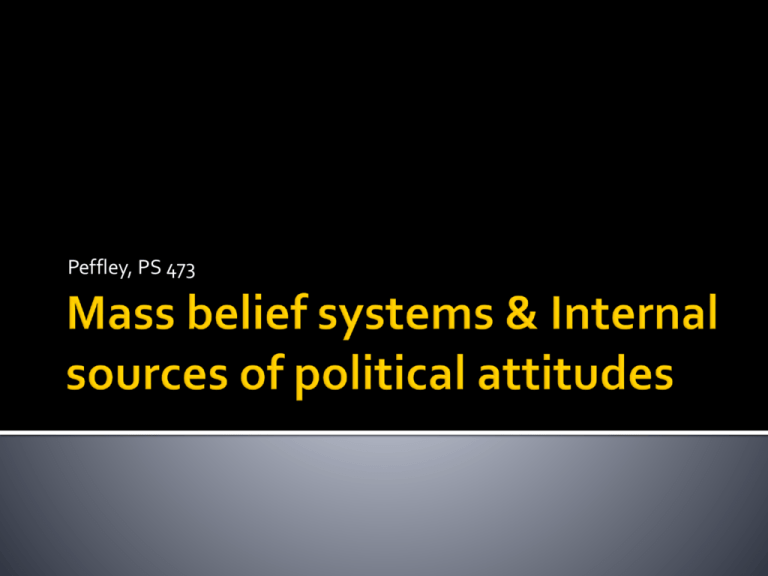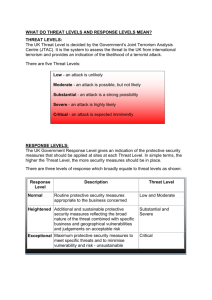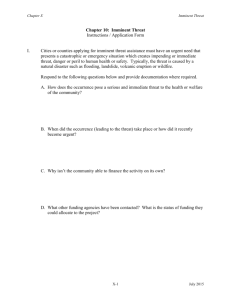The Authoritarian Personality
advertisement

Peffley, PS 473 More Money Doesn't Mean More Sex, but More Sex Can Make You Feel Richer By Sid Kirchheimer WebMD Health News July 16, 2004 -- Good news for folks whose bedrooms have more activity than their bank accounts: New research shows that sex is better for your happiness than money. Dartmouth College economist David Blanchflower and Andrew Oswald of the University of Warwick in England report that sex "enters so strongly (and) positively in happiness equations" that they estimate increasing intercourse from once a month to once a week is equivalent to the amount of happiness generated by getting an additional $50,000 in income for the average American. "The evidence we see is that money brings some amounts of happiness, but not as much as what economists might have thought," says Blanchflower. "We had to look to psychologists and realize that other things really matter.“ Their paper, "Money, Sex, and Happiness: An Empirical Study," recently published by the National Bureau of Economic Research, essentially puts an estimated dollar amount on the happiness level resulting from sex and its trappings. Overall, the happiest folks are those getting the most sex -- married people, who report 30% more between-the-sheets action than single folks. In fact, the economists calculate that a lasting marriage equates to happiness generated by getting an extra $100,000 each year. Divorce, meanwhile, translates to a happiness depletion of $66,000 annually. Whether that hefty happiness income boost is the result of marital bliss or more sex is up for debate. But their "econometric" calculations confirm what psychologists have long known: People who consider themselves happy are usually richer in sexual activity. Does sex lead to happiness, or are happy people just more likely to lead each other to the bedroom? That's still under investigation, but there is evidence that psyche and sex feed off each other. Take that study in the May 2001 issue of the Journal of Sex Research, in which Georgia State University researchers found that people who are involuntarily celibate are frequently afflicted with nonhappy feelings -- anger, frustration, self-doubt, and even depression. They conclude it's the result of "missed opportunities" of living without sex. “Ideological innocence” Internal sources of political attitudes http://typology.people-press.org/typology/ Political elites & attentive masses use ideologies to talk about politics & organize their political attitudes. However: Mass public not consistently liberal & conservative across different issue domains Don’t know the meaning of liberal and conservative Often have difficulty determining the liberal and conservative sides of political issues Group identifications Partisan identification Ideological identification Other group identifications (e.g., racial, ethnic, religious, gender) structure attitudes toward political objects (e.g., candidates, policies) associated with ingroups & outgroups General beliefs Values Worldview Personality Political attitudes organized within separate policy domains versus ideologies that cut across policy domains Specific policy attitudes organized by domain-specific heuristics, such as values, general beliefs and attitudes toward groups associated with the policy. Economic Attitudes Values Individualism, Foreign Policy Attitudes Patriotism, Egalitarianism, Humanitarianism General Beliefs & Postures Policy Attitudes Morality of Warfare Beliefs about Welfare Dovish or Hawkish Posture Welfare Opposition or Support Iraq War Opposition or Support At the individual level: emotional, "easy" heuristics; value priorities predict policy attitudes. At the societal level: value consensus identifies political culture. Value structures or hierarchies, value conflict or ambivalence (Rokeach). Individualism, work ethic and beliefs about economic opportunity, values and beliefs that some call the “American Dream,” the belief that: Success is determined by hard work & Opportunities for success are available to everyone i.e., what some call the Horatio Alger myth, the rags to riches story in America Do you strongly agree, agree, disagree or strongly disagree with the following statements? Any person who is willing to work hard has a good chance of succeeding? Hard work offers little guarantee of success? Most people who don't get ahead should not blame the system; they really have only themselves to blame? Even if people are ambitious, they often cannot succeed. If people work hard, they almost always get what they want? Even if people try hard, they often cannot reach their goals? Rokeach’s Value System, Value Hierarchy, 1 to 18 A comfortable life (a prosperous life) An exciting life (a stimulating, active life) A sense of accomplishment (lasting contribution) A world at peace (free of war and conflict) A world of beauty (beauty of nature and the arts) Equality (brotherhood, equal opportunity for all) Family security (taking care of loved ones) Freedom (independence, free choice) Happiness (contentedness) Inner harmony (freedom from inner conflict) Mature love (sexual and spiritual intimacy) National security (protection from attack) Pleasure (an enjoyable, leisurely life) Salvation (saved, eternal life) Self-respect (self-esteem) Social recognition (respect, admiration) True friendship (close companionship) Wisdom (a mature understanding of life) Hi Freedom Capitalism Socialism Hi Equality Low Equality Fascism Communism Low Freedom THE PREJUDICED PERSONALITY INTOLERANT PERSONALITY UNDEMOCRATIC PERSONALITY 1. Adorno et al., The Authoritarian Personality (1950) Psychoanalytic interpretation Problems with the F-scale: yea-saying, right-wing 2. Bob Altemeyer, Right-Wing Authoritarianism Correction for yea-saying (see scale) Three traits ▪ Authoritarian submission ▪ Authoritarian aggression ▪ Conventionalism Common law breakers are seen as a lower form of life which do not deserve fairness and protection under the law MIRROR IMAGE TRIALS WILLINGNESS TO JOIN A HYPOTHETICAL POSSE ACTS OF INTOLERANCE Version 1: Langley is leading a pro-gay demonstration to support a law prohibiting discrimination against gays. He incites an attack against counterdemonstrators. What should be his punishment? Imagine that you are the judge presiding over the trial of Mr. William Langley. Mr. Langley is a 44-year-old civil servant who is also the founder and president of the Winnipeg chapter of Canadians for Gay Rights, a noted prohomosexual organization. A few years ago Mr. Langley was leading a demonstration on the steps of the Manitoba Legislature, supporting a proposed law which would have prohibited discrimination against homosexuals in housing and certain fields of employment. A crowd of approximately 100, mainly members of Mr. Langley's organization, had gathered around his speaker's stand. A large banner which read "GAY POWER" was tied between two columns immediately behind…, a group of about 30 counterdemonstrators appeared and began to walk slowly and silently around the outside of Mr. Langley's audience. They carried signs which read "THE FAMILY IS SACRED" and "NO GAY RIGHTS." …according to several witnesses, Mr. Langley said,…” I say we run them out of here right now. Let's show everybody we mean business." Version 2: Langley is leading an anti-gay demonstration to support allowing discrimination against gays. Otherwise the rest of the narrative is the same. Local Manitoba samples, usually students No theory of when authoritarianism is activated His measure confounds authoritarianism with social conservatism (conventionalism) Research on Manitoba students’ sexual behavior Social Conformity Versus Autonomy (Feldman, 2003) Conformity Versus Autonomy A. We should admire people who go their own way without worrying about what others think. B. People need to learn to fit in and get along with others. Freedom Versus Fear of Disorder A. It is most important to give people all the freedom they need to express themselves. B. Our society will break down if we allow people to do or say anything they want. Respect for Common Norms and Values A. Rules are there for people to follow, not to change. B. Society's basic rules were created by people and so can always be changed by people. Social Cohesion A. Society should aim to protect citizens' right to live any way they choose. B. It is important to enforce the community's standards of right and wrong. Socialization and Child-Rearing Values A. The most important values children should learn are obedience and respect for authority. B. The most important values children should learn are independence and self-reliance. Note: Respondents were asked whether they strongly agree, agree, disagree or strongly disagree with the above statements. Survey items were administered randomly. Marc J. Hetherington & Jonathan Weiler Hetherington & Weiler, Ch 2 1. Moderation. Today as in the past, most Americans are ideological moderates, holding a mixture of liberal and conservative views on different issues. 2. Partisan Polarization. Partisan polarization is largely an elite phenomenon— i.e., elected officials and activists. 3. Geographical Polarization. Cultural and political differences between red states and blue states are actually fairly small. (The similarities between voters in these two sets of states are much more striking than the differences.) 4. Social Cleavages. Divisions within the public based on social characteristics (age, race, gender, and religious affiliation) have been diminishing, not increasing and are smaller than traditional economic divisions between the parties. 5. Political Turnoff. Growing polarization of party elites and activists turns off large numbers of voters and depresses turnout in elections. A wide dispersion of preference between groups moving toward a bimodal distribution, or a clustering of preferences near the poles. In statistical terms, this rendering requires 1) a large difference of means (or proportions) between two groups and 2) large and increasing standard deviations in distributions of interest Statistical definitions of popular polarization (bimodal distributions) are hard to find in the real world, especially across average issues and average people. Types of issues: Statistical definitions do not take into account new issues, issue salience, strong feelings, and an inability or unwillingness to understand contrary points of view (e.g., gay rights, terrorism and the Iraq war) Types of people: Party sorting looks like polarization among engaged partisans, not just the party elite (activists and politicians) Coburn’s claim: Analysts on CNN, Fox News, etc. do the SAME THING as political scientists who study elections. By Coburn’s logic, we can just go ahead and do away with government funding of medical research too, since CNN’s got Dr. Sanjay Gupta on the case. Coburn, an OB/GYN, claimed his advice to a GOP Senate colleague, John Ensign, who was having a long-term affair with his top aide’s wife (and paid off the husband with campaign funds) was protected by “physician-patient privilege.” Hetherington & Weiler, Ch 3 AU is fundamentally motivated by a need for order & support for authorities seen as best able to secure that order against a variety of threats to social cohesion. AU is associated with a belief in Biblical inerrancy A tendency to rigid thinking and an unwillingness or inability to process new information that might challenge such thinking AU forms the basis for a worldview, not a personality trait AU & conservatism aren’t the same thing Situationism Several features are common to nonauthoritarians: a strongly held notion of fairness that manifests itself as outgroup preference; a tendency toward accuracy motivation; an aversion to prejudicial thinking, valuing personal autonomy over social conformity (Feldman) an aversion to judgments, making them relativistic, a tendency to be broadly opinionated Values in Children vs Actual childrearing practices. “I am going to read you pairs of values. Which value is more important for a child to have?” (p. 48) 1. Independence? or Respect for elders? 2. Curiosity? or Good manners? 3. Being considerate or Being well-behaved? 4. Obedience or Self-Reliance? Construct validity refers to whether a scale measures or correlates with the theorized psychological construct (e.g., “authoritarianism") that it purports to measure. AU is correlated with: Need for cognition (low AU agree) ▪ “I would prefer complex to simple problems.” ▪ “I like to have the responsibility of handling a situation that requires a lot of thinking.” ▪ “I have opinions on most things.” Intelligence (interviewer rating), education, political knowledge Need for order ▪ “Personally, I tend to think that there is a right way and a wrong way to do almost everything” ▪ “Nothing gets accomplished in this world unless you stick to some basic rules” Political & social tolerance toward unpopular groups Is there still a pejorative element to defining these two groups? Could you define these characteristics in different ways to alter the relative appeal of the two groups? Chapter 4 Issue evolution (Carmines and Stimson) & its key intervening steps: party sorting to win elections, mass change in response to elite changes Worldview Worldview evolution 1) Racial & ethnic difference 2) Crime, law & order, and civil liberties 3) ERA/feminism/family structure 4) American militarism, diplomacy and the aftermath of Vietnam. What do these issues have in common, both historically and currently? Chapter 5 Gay Rights The War on Terror Political, Social Chars AU Gay Rights 1. 2. 3. 4. As you may know, federal government agencies have recently been given more power to use electronic surveillance to monitor phone calls and emails within the United States without first getting a court warrant to do so. Do you consider this an acceptable or unacceptable way for the federal government to investigate terrorism? Some people think installing video cameras in public places is a good idea because they may help to reduce the threat of terrorism. Other people think this is a bad idea because surveillance cameras may infringe on people's privacy rights. What do you think? Would you say this it is a good idea or a bad idea to install surveillance cameras in public places? These days, if someone disagrees with the president on issues relating to terrorism, do you think it is okay to criticize him publicly, or should people not criticize the president on issues relating to terrorism? Do you think the news media should - or should not - report information it obtains about the secret methods the government is using to fight terrorism? 80 70 Percent 60 50 Offended at Happy Holidays vs. Merry Christmas 40 30 20 10 0 Everyone High AU Low Au Chapter 6 The impact of one independent variable (AU) on the dependent variable (gay rights) depends on the level of another independent variable (perceived threat). low hi A positive interaction between perceived threat & AU: •Conventional wisdom in the Lab: The influence of AU should increase when threat is increases because hi-AUs are more likely to perceive the threat. •In the real world, this is not likely, according to H&W. A negative interaction between overall perceived threat (terrorism) & AU: •When overall threat is so high that non-AUs perceive more threat, they act more like authoritarians, so knowing whether someone is high or low on the AU scale doesn’t help predict their behavior. •When overall threat is lower, hi AU’s & low-AUs differ a lot (only hi AUs perceive threat), so knowing where a person is on the AU scale is more helpful in predicting their behavior. Perceived threat = “The newer lifestyles are contributing to the breakdown of our society". In 2004, the interaction between AU & perceived threat was negative. •For people who perceived high threat from alternative lifestyles (> .5), AU made no difference •For those who perceived little threat (<.5) , AU had the greatest impact on Gay Adoption. Perceived Threat = "How worried are you that you personally might become a victim of a terrorist attack?" •If people were very worried about a terrorist attack, they supported curtailing civil liberties, regardless of AU. •If they were not worried, AU had the biggest impact on support for curtailing civil liberties. Perceived Threat = "How worried are you that you personally might become a victim of a terrorist attack?" If people were very worried about a terrorist attack, they approved of GWB regardless of AU. If they were not worried, AU had the biggest impact on GWB approval. Perceived Threat = "How worried are you that you personally might become a victim of a terrorist attack?" If people were very worried about a terrorist attack, they preferring strength vs diplomacy regardless of AU. If they were not worried, AU had the biggest impact on Preferring Strength vs Diplomacy. Increased threat often increases the number of people supporting policies or candidates that promise to impose more order. Because people who score high in AU already tend to support such initiatives, higher levels of threat narrow the differences between high & low AUs—i.e., makes AU less predictive of political attitudes. Chapter 7 Steps of issue evolution, Chs 4 & 7 Extension to worldview evolution and the widening of the cleavage formed along racial issues Reflected in voting behavior, partisanship & party sorting, and an asymmetry among non-authoritarians









